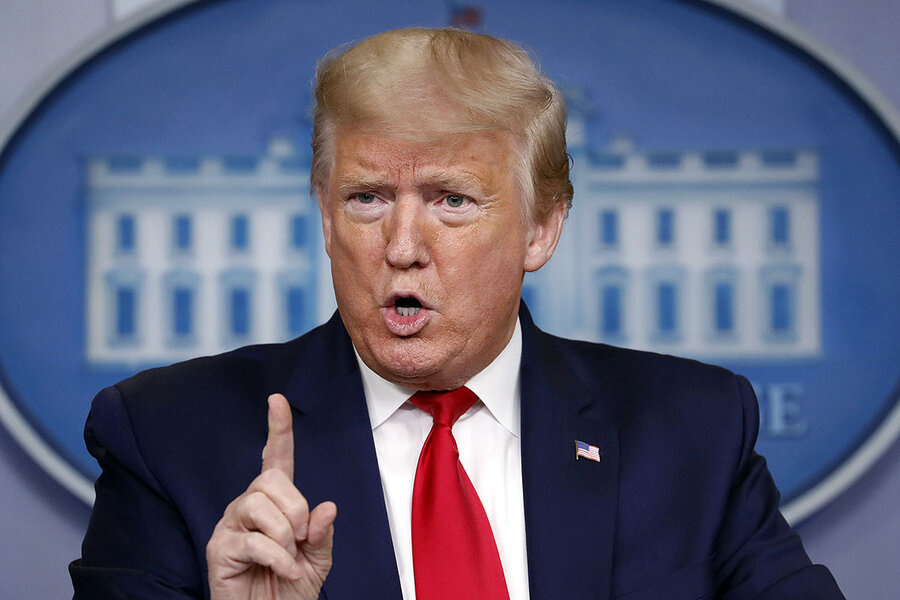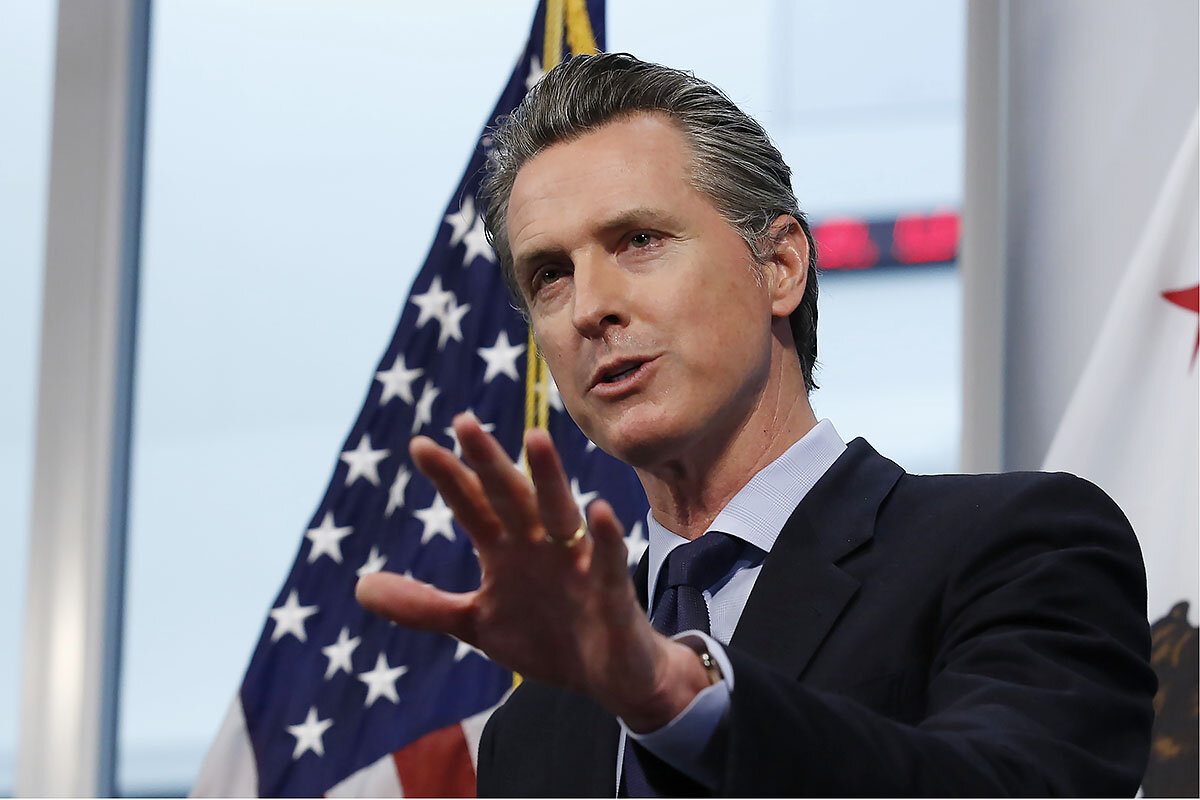In scramble for supplies, states start banding together
Loading...
| Washington
The nation’s multi-layered, federalist form of government is facing the test of a lifetime, as states grapple with shortages of equipment and are banding together to do what the federal government can’t or won’t do for them.
A depleted Strategic National Stockpile has states competing among themselves and with the federal government for personal protective equipment. “They’re losing out to the entity that told them to buy it. It’s just bonkers,” says Jeremy Konyndyk, a senior policy fellow at the Center for Global Development and a former Obama-era official.
Why We Wrote This
During disasters, the federal government backs up the states. But when the crisis is nationwide, a lack of coordination can lead to mayhem. Some are pushing for an overarching “czar,” as states scramble to fill the gaps.
Still, states are rising to the occasion and helping each other. In the Midwest, a consortium of states is working together on purchasing supplies to avoid competition that drives up prices. In the West, the governors of Oregon and California have been loaning ventilators to other states as their case loads recede.
Last Saturday, Oregon Gov. Kate Brown tweeted that she was sending 140 ventilators to New York, noting that her state was “in a better position right now.”
Vice President Pence applauded the move at that day’s briefing. Oregon, he said, was acting “in the very highest American tradition of loving your neighbor.”
President Donald Trump calls himself a “wartime president” against an “invisible enemy,” the novel coronavirus.
Indeed, there is no disputing the warlike nature of the threat, as governments around the globe and at all levels in the United States, along with the private sector, nonprofits, and individuals rally to save as many lives as possible and defeat the adversary.
But in the U.S., beneath this picture of resolve and shared sacrifice lies a stark reality: The nation’s multilayered, federalist form of government is facing the test of a lifetime, as states grapple with shortages of equipment and are banding together to do what the federal government can’t or won’t do for them.
Why We Wrote This
During disasters, the federal government backs up the states. But when the crisis is nationwide, a lack of coordination can lead to mayhem. Some are pushing for an overarching “czar,” as states scramble to fill the gaps.
The depletion of the Strategic National Stockpile and the inability of the Federal Emergency Management Agency, or FEMA, to fill these needs has forced such action, governors say. In the Midwest, a consortium of states is working together on purchasing supplies to avoid competition that drives up prices.
In the West, the governors of Oregon and California have swung into action, loaning ventilators to other states as their case loads recede. Gov. Gavin Newsom of California is also using his state’s purchasing power to acquire millions of pieces of protective equipment for his own state’s use and potentially for neighboring states.
Editor’s note: As a public service, we’ve removed the paywall for all our coronavirus coverage. It’s free.
To veterans of past public health emergencies, the scramble for supplies reflects a flat-footed U.S. response born of overconfidence after past epidemics, such as SARS, were thwarted with minimal American casualties.
Delays in testing set back the U.S. response by weeks, and as the outbreak grew, the nation’s command-and-control systems were simply not up to the task, says Dr. Elias Zerhouni, former director of the National Institutes of Health under President George W. Bush.
“You win the war not by heroics,” Dr. Zerhouni says. “You win the war by good logistics.”
And it’s logistics that have proved painfully challenging to the U.S.’s multi-tiered, federal-state-local system of government, in which each piece plays a critical role. During disasters, states are supposed to take the lead and the federal government is meant to serve as a backup. But when the disaster is nationwide – in fact, global – the potential for the system being swamped was always high.
“A statewide or regional disaster is one thing, but an emergency that affects all 50 states is something else,” says Joshua Sharfstein, a public health expert at Johns Hopkins University in Baltimore. “The federal government is supposed to provide the framework for the states to act in. On that, the government has in many ways largely abdicated.”
Even in regional disasters, a strong federal response can prove essential, as it was in 2005, when Hurricane Katrina slammed the Gulf Coast and state and local authorities proved unable to manage the disaster. Often, then, it’s the leaders involved who can make or break a situation.
Looking at today’s pandemic, “I don’t think any disarray, such as it is, is caused by federalism,” says Ilya Shapiro, a constitutional scholar at the libertarian CATO Institute in Washington. The federal government’s job is to look out for the country as a whole, while the governors need the flexibility to do what’s right for their state, he notes. New York is not South Dakota.
Part of the challenge today comes with the Trump administration’s multiple chains of command: President Trump puts himself out front daily in televised briefings, making himself the prime authority. He’s backed by a White House Coronavirus Task Force that has many coordinators, including Vice President Mike Pence, Dr. Deborah Birx, and various Cabinet members and other presidential advisers who handle different aspects of the response.
Mr. Trump’s son-in-law and senior adviser Jared Kushner also has a hand in the task force, and caused a flap recently when he scolded states for not building up their own stockpiles of supplies. The Strategic National Stockpile, he said, is “supposed to be our stockpile – it’s not supposed to be state stockpiles that they then use.” The Department of Health and Human Services soon changed its website to reflect his comments, adding more tension with states.
When asked about logistics, the president used to point to the director of FEMA, Pete Gaynor. But more recently, it’s been Rear Adm. John Polowczyk, the supply chain task force lead at FEMA, and Adm. Brett Giroir, the coronavirus “testing czar.”
Even amid a national crisis, Mr. Trump has continued his rampage against inspectors general, who are meant to be a semi-independent check on federal government activities. Last week, he fired the inspector general of the intelligence community, fallout from his agitation over impeachment. On Tuesday, he fired the inspector general meant to oversee the group charged with monitoring the coronavirus relief fund. The day before, at his briefing, he attacked the acting inspector general of HHS, who had released a report about hospitals facing severe shortages of equipment needed to fight the pandemic.
Veterans of past disasters point to the need for an overarching “czar” – such as a high-ranking military figure – who has the president’s full confidence and superior organizational skill.
Adm. Thad Allen, former commandant of the Coast Guard, served that function for both the second President Bush, during Katrina, and President Barack Obama, during the 2010 Deepwater Horizon oil spill in the Gulf of Mexico.
In a podcast with the Partnership for Public Service’s Center for Presidential Transition, Admiral Allen notes that the two presidents he served had different styles, but there was a common denominator: the need to separate the disaster from political concerns, have the authority to set up the appropriate framework, and execute the plan. His motto: Every crisis is an exercise in applied civics.
“Both gave me wide rein to figure out what the problem was, make recommendations to them, speak frankly to the American people, and be held accountable and be removed if I wasn’t doing the job,” Admiral Allen says.
Senate Democratic leader Chuck Schumer has pressed Mr. Trump to appoint a top military figure to run the pandemic response, but so far to no avail.
Admiral Allen responds carefully when asked if he’d be willing to come out of retirement to lead the U.S. response on COVID-19.
“Some of the basic tenets that allowed me to be successful may or may not exist in this current administration,” the admiral says, noting specifically the ability to speak freely and honestly with the American people. If the conditions were right, he said, he’d “always consider helping the country out.”
Other past disaster-response officials are less diplomatic when looking at today’s crisis.
“The federal government has to take ownership of this response, because it’s a national level crisis,” says Jeremy Konyndyk, a senior policy fellow at the Center for Global Development and a former Obama-era foreign aid official. “But it can’t do that if the president isn’t willing to step up. It seems like the president wants the attention but not the responsibility.”
A depleted Strategic National Stockpile also has states competing among themselves and with the federal government for personal protective equipment. “They’re losing out to the entity that told them to buy it. It’s just bonkers,” says Mr. Konyndyk.
But faced with the reality of needing to be proactive on supplies, states are rising to the occasion and helping each other. Last Saturday, Oregon Gov. Kate Brown tweeted that she was sending 140 ventilators to New York, a global hot spot for the virus, noting that her state was “in a better position right now.”
Vice President Pence applauded the move at that day’s briefing. Oregon, he said, was acting “in the very highest American tradition of loving your neighbor.”
Editor’s note: As a public service, we’ve removed the paywall for all our coronavirus coverage. It’s free.








